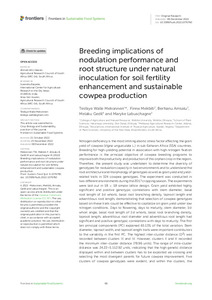| dc.contributor.author | Mekonnen, T.W. |
| dc.contributor.author | Hailemariam, F.M. |
| dc.contributor.author | Amsalu, B. |
| dc.contributor.author | Gedil, M. |
| dc.contributor.author | Labuschagne, M.T. |
| dc.date.accessioned | 2023-01-18T11:17:51Z |
| dc.date.available | 2023-01-18T11:17:51Z |
| dc.date.issued | 2022-12-08 |
| dc.identifier.citation | Mekonnen, T.W., Hailemariam, F.M., Amsalu, B., Gedil, M. & Labuschagne, M.T. (2022). Breeding implications of nodulation performance and root structure under natural inoculation for soil fertility enhancement and sustainable cowpea production. Frontiers in Sustainable Food Systems, 6: 1076760, 1-14. |
| dc.identifier.issn | 2571-581X |
| dc.identifier.uri | https://hdl.handle.net/20.500.12478/8009 |
| dc.description.abstract | Nitrogen deficiency is the most limiting abiotic stress factor affecting the grain yield of cowpea (Vigna unguiculata L.) in sub-Saharan Africa (SSA) countries. Breeding for high-yielding potential in association with high nitrogen fixation performance is the principal objective of cowpea breeding programs to improve both the productivity and production of this orphan crop in the region. Therefore, the present study was undertaken to determine the diversity of genotypes for nodulation capacity in two environments and to understand the root architecture and morphology of genotypes as well as grain yield and yield-related traits in 324 cowpea genotypes. The experiment was conducted in two different environments during the 2017 cropping season. The experiments were laid out in 18 × 18 simple lattice design. Grain yield exhibited highly significant and positive genotypic correlations with stem diameter, basal root length of 1st whorls, basal root branching density, taproot length and adventitious root length, demonstrating that selection of cowpea genotypes based on these traits could be effective to capitalize on grain yield under low nitrogen conditions. Days to flowering, days to maturity, stem diameter, 1st whorl angle, basal root length of 1st whorls, basal root branching density, taproot length, adventitious root diameter and adventitious root length had significant and positive genotypic correlations with days to maturity. The first ten principal components (PC) explained 65.13% of the total variation. Stem diameter, taproot width, and taproot length traits were important contributors to the variability in the first PC. The highest inter-cluster distance (D2) was recorded between clusters III and IV. However, clusters II and V recorded the minimum inter-cluster distance (78.96 units). The range of intra-cluster distance was 24.22–5,112.92 units, indicating that the high genetic distance displayed within and between clusters has to be exploited via crossing and selecting the most divergent parents for future cowpea improvement. Five clusters of cowpea genotypes were evident, and within the clusters, the genotypes had good nodulation potential with high grain yield traits, which could significantly contribute to SSA food and nutritional security. Moreover, it can contribute to resilience and improve crop production and sustainability under marginal environmental conditions. |
| dc.description.sponsorship | McKnight Foundation |
| dc.format.extent | 1-14 |
| dc.language.iso | en |
| dc.subject | Cowpeas |
| dc.subject | Environment |
| dc.subject | Nodulation |
| dc.subject | Root Architecture |
| dc.subject | Phenotypes |
| dc.subject | Ethiopia |
| dc.title | Breeding implications of nodulation performance and root structure under natural inoculation for soil fertility enhancement and sustainable cowpea production |
| dc.type | Journal Article |
| cg.contributor.crp | Maize |
| cg.contributor.crp | Roots, Tubers and Bananas |
| cg.contributor.affiliation | Wolkite University |
| cg.contributor.affiliation | Haramaya University |
| cg.contributor.affiliation | Melkassa Agricultural Research Center, Ethiopia, |
| cg.contributor.affiliation | International Institute of Tropical Agriculture |
| cg.contributor.affiliation | University of the Free State |
| cg.coverage.region | Africa |
| cg.coverage.region | East Africa |
| cg.coverage.country | Ethiopia |
| cg.coverage.hub | Headquarters and Western Africa Hub |
| cg.researchtheme | Biotech and Plant Breeding |
| cg.isijournal | ISI Journal |
| cg.authorship.types | CGIAR and developing country institute |
| cg.iitasubject | Agronomy |
| cg.iitasubject | Cowpea |
| cg.iitasubject | Crop Systems |
| cg.iitasubject | Food Security |
| cg.iitasubject | Grain Legumes |
| cg.iitasubject | Plant Breeding |
| cg.iitasubject | Plant Genetic Resources |
| cg.iitasubject | Plant Production |
| cg.iitasubject | Soil Fertility |
| cg.iitasubject | Soil Information |
| cg.journal | Frontiers in Sustainable Food Systems |
| cg.notes | Open Access Journal; Published online: 08 Dec 2022 |
| cg.accessibilitystatus | Open Access |
| cg.reviewstatus | Peer Review |
| cg.usagerightslicense | Creative Commons Attribution 4.0 (CC BY 0.0) |
| cg.targetaudience | Scientists |
| cg.identifier.doi | https://dx.doi.org/10.3389/fsufs.2022.1076760 |
| cg.iitaauthor.identifier | Melaku Gedil: 0000-0002-6258-6014 |
| cg.futureupdate.required | No |
| cg.identifier.issue | 1076760 |
| cg.identifier.volume | 6 |

